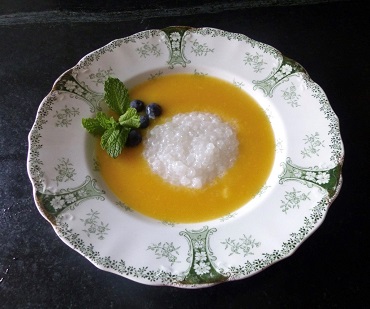
The Proven Platter – Uganda
Hello Diners!
We are going to Uganda this month in support of DIG, Development in Gardening. DIG provides experiential training in sustainable agriculture, nutrition and improved cooking practices, along with developing 400 women-led home gardens.
It is July, it’s hot, and I’m hoping that you’ll be able to do some grilling. I’ve got Beef Skewers in Green Masala on the menu, although you could certainly use chicken or pork if you prefer. A Cabbage Salad with Pineapple presents a fresh new take on coleslaw with an African twist. And for dessert, we have a stunning Mango Coulis with Tapioca.
When was the last time you made tapioca? Right – that’s what I thought. Ages ago, or maybe never! Tapioca is derived from cassava, as the plant is known in Africa, or yuca, as it is known in Latin America. (The word manioc is also sometimes used to refer to the plant and to the starch produced when its roots are dried and leached in preparation for cooking.) Cassava was brought to Africa by Spanish and Portuguese traders and has been a staple food ever since. In West Africa cassava is eaten daily, pounded into a mash called “fufu.” If you’ll remember, I wrote about yuca just a few months ago when our focus was on Nicaragua and we made Vigoron, a salad that included boiled yuca root. This time we are using the end result of drying cassava – tapioca – to make a dessert.
I’ve taken inspiration from a cookbook written by Marcus Samuelsson, “The Soul of a New Cuisine: A Discovery of the Foods and Flavors of Africa,” for two of my recipes this month, the beef skewers and the dessert. Marcus shares many traditional African recipes in his book, along with updated and modernized versions suitable for American palates. For example, his recipe for Tangerine Consommé with Tapioca is brilliant, and I have adapted and streamlined the recipe for my taste and preference, taking traditional ingredients like mangoes, coconut milk, and tapioca, and turning everything into an entirely American concept. I’ve renamed the recipe Tapioca with Mango Coulis as this reflects the changes I’ve made. This is not the tapioca pudding of your childhood, but rather a lovely and sophisticated dessert for adults, with childhood memories included.
Please shoot me an email at nw4@togetherwomenrise.org if you have any questions about the recipes or would like to make a comment. And I’d like to give a big shout-out to the awesome ladies in the Northeast Region who attended their chapter leader retreat; they sent the most unusual thank you card I’ve ever received. You sure know how to make a gal feel appreciated!
Tapioca with Mango Coulis
Serves 8
This refreshing dessert is perfect for a summer day. You’ll need to plan ahead for this, but that’s a good thing. Both components of this dessert can and should be made one day ahead of time. The tapioca will need to soak for four hours before you even get started, so make sure to factor that into your planning.
The soaking really makes a big difference in how the grains plump up. While the original instructions called for an overnight soak, I found that was too long. The tapioca dissolved in my fingertips. I then tried four hours and found that was just right. I also experimented with not soaking the tapioca before cooking, and I found that result wasn’t nearly as satisfactory as the soaked tapioca, so I highly recommend that you don’t skip this step.
Finally, make sure your box of tapioca is fresh, and not pulled from the dusty depths of your cupboard. You want to purchase small pearl tapioca, not the instant or large pearl variety.
Ingredients
1 cup sugar, divided
2 lemons
1 vanilla bean or 1 tsp. vanilla extract
1 cup fresh-squeezed orange juice
One 10-oz bag frozen mango chunks, pureed (makes about 1 cup puree)
½ cup small pearl tapioca, soaked 4 hours in 2 cups of water
One 15-oz. can coconut milk
Fresh berries, for garnish
Mint sprigs, for garnish
Directions
To make the mango coulis: Put ½ cup of the sugar into a small saucepan. Grate the zest of two lemons right into the pan. Squeeze juice from the lemons into a separate bowl and reserve. If you are using a vanilla bean split the bean lengthwise and scrape seeds into the pan with sugar. Or just add vanilla extract. Add 1 cup of water and bring to a simmer, just until sugar is dissolved. Remove from heat and let cool. Strain syrup into a container and stir in reserved lemon juice, orange juice, and mango puree. Refrigerate overnight, or until thoroughly chilled.
Combine the pre-soaked tapioca (including the remaining soaking liquid), coconut milk, and remaining ½ cup sugar in a saucepan and bring to a boil. Reduce heat to low and simmer, stirring constantly; the tapioca should start to thicken almost immediately and become somewhat gloppy. When finished, the tapioca pearls should look translucent and have swollen to about twice their size. When tasting a spoonful, the texture should be gelatinous, without any crunchy bits left. The timing should be less than five minutes. Remove from heat and let cool. As the tapioca cools it will thicken considerably. Refrigerate overnight for best texture.
To serve, divide tapioca among eight shallow soup bowls. I used a 1/3 cup ice-cream scoop to dish out the tapioca in order to get nice rounded mounds. Pour mango coulis around the tapioca. Garnish with fresh berries and mint.
Recipe heavily adapted from “The Soul of a New Cuisine: A Discovery of the Foods and Flavors of Africa,” by Marcus Samuelsson
Photo credit: Linda McElroy
